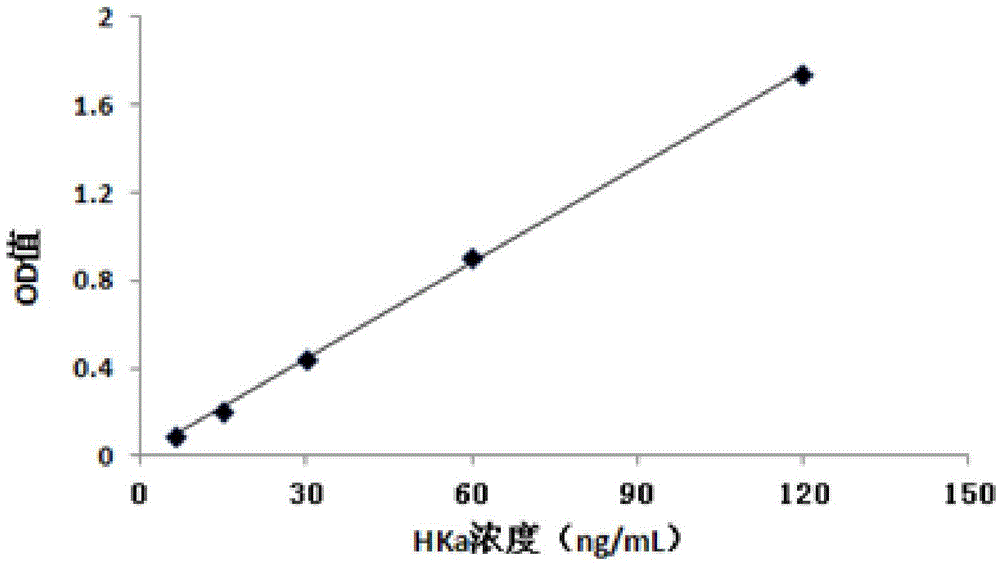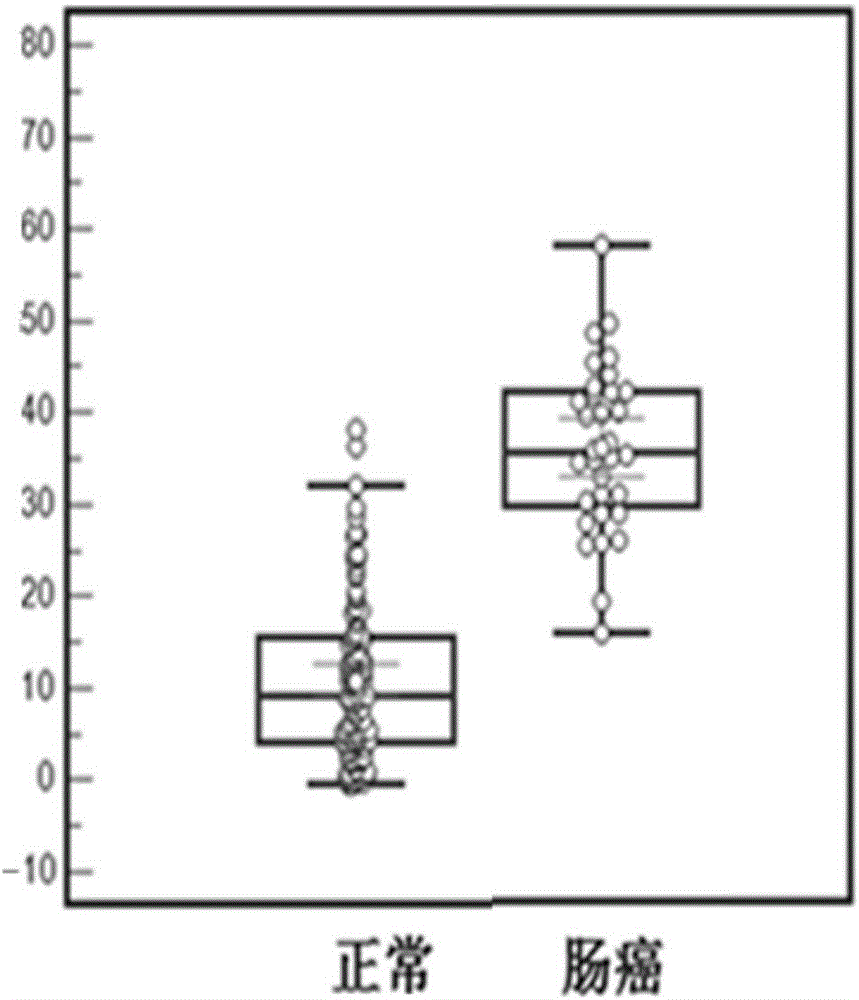Polypeptide-protein combined-type marker" detection kit relative to colorectal cancer
A technology of colorectal cancer and kits, applied in the field of biotechnology detection, to achieve good accuracy and sensitivity
- Summary
- Abstract
- Description
- Claims
- Application Information
AI Technical Summary
Problems solved by technology
Method used
Image
Examples
Embodiment 1
[0071] Example 1: Optimization of Detection Conditions for Capture Antibodies and Detection Antibodies
[0072] 1) Dilute the capture antibody with coating buffer to 50ng / mL, 100ng / mL, 250ng / mL, 500ng / mL, 1000ng / mL and 2000ng / mL, respectively, according to 100μL / well, and place overnight at 4°C.
[0073] 2) Take the ELISA plate coated with the capture antibody in the kit, add 100 ng / mL HKa standard to each well, 100 μL per well. Incubate at 37°C for 1.5 hours;
[0074] 3) Discard the solution, wash each well 5 times with 300 μL PBST washing buffer, and pat dry;
[0075] 4) Dilute the HRP-labeled detection antibody with PBST at 1:500, 1:1000, 1:2000, 1:4000, 1:8000, 1:16000, 1:32000, add 100 μL to each well, and stand at 37°C Incubate for 40 minutes;
[0076] 5) Discard the solution, wash each well with 300 μL PBST washing buffer 5 times, and pat dry;
[0077] 6) Add 100 μL of TMB substrate chromogenic solution interacting with HRP to each well, and develop color at 37°C in...
Embodiment 2
[0080] Embodiment 2: the preparation of kit
[0081] 1. Preparation of reagents
[0082] Carbonate coating buffer: pH9.6, 0.1mol / L, weighed Na 2 CO 3 1.59g, NaHCO 3 Add 2.93g of deionized water to 1000ml.
[0083] PBST washing buffer: pH value is 7.4, including 80mmol / L Na 2 HPO 4 , KH of 20mmol / L 2 PO 4 , KCl of 100mmol / L, NaCl of 1400mmol / L, Tween-20 whose volume fraction is 0.5%.
[0084] TMB Chromogenic Solution: Substrate Chromogenic Solution A: Sodium Acetate 13.6g, Citric Acid 1.6g, 30% Hydrogen Peroxide 0.3ml, Distilled Water to 500ml; Substrate Chromogenic Solution B: Disodium EDTA 0.2g, Citric acid 0.95g, glycerin 50ml, 0.15g TMB was dissolved in 3ml DMSO, and distilled water was added to 500mL. Take substrate color development solution A and mix equal volumes of substrate color development solution B to obtain TMB color development solution.
[0085] Sulfuric acid stop solution: prepare a 2M sulfuric acid aqueous solution.
[0086] 2. Coating of capture...
Embodiment 3
[0092] Example 3: Identification of the minimum detection limit and detection range of the kit
[0093] Get the kit that embodiment 2 makes, prepare the HKa standard solution of gradient concentration as the sample to be tested, the concentration of HKa standard is: 0ng / mL, 30ng / mL, 60ng / mL, 90ng / mL, 120ng / mL, 150ng / mL.
[0094] Take the ELISA plate coated with the capture antibody in the kit, add different concentrations of HKa standard solution, 100 μL per well, and repeat 3 times for each concentration. Incubate at 37°C for 1.5 hours; discard the solution, wash each well 5 times with 300 μL PBST buffer in the kit, and pat dry;
[0095] Add 100 μL of HRP-labeled detection antibody to each well, and incubate at 37°C for 40 minutes; discard the solution, wash each well 5 times with 300 μL of PBST buffer in the kit, and pat dry;
[0096] Add 100 μL of TMB chromogenic solution to each well, and develop color at 37°C in the dark for 15 minutes; add 50 μL of 2mol / L sulfuric acid...
PUM
 Login to View More
Login to View More Abstract
Description
Claims
Application Information
 Login to View More
Login to View More - R&D Engineer
- R&D Manager
- IP Professional
- Industry Leading Data Capabilities
- Powerful AI technology
- Patent DNA Extraction
Browse by: Latest US Patents, China's latest patents, Technical Efficacy Thesaurus, Application Domain, Technology Topic, Popular Technical Reports.
© 2024 PatSnap. All rights reserved.Legal|Privacy policy|Modern Slavery Act Transparency Statement|Sitemap|About US| Contact US: help@patsnap.com










